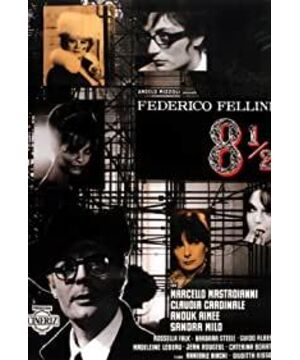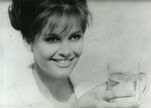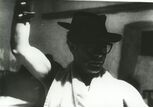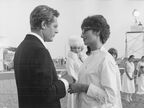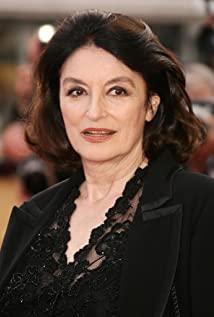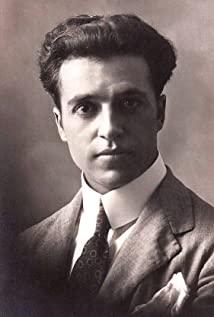Federico Fellini is one of the most influential directors of the twentieth century. Although most people agree with these statements, how great is Fellini as a director? This question is actually like "what should a good movie look like?" It is an unanswerable question.
Film is an art that conveys a subjective and personal feeling. It is not a concrete thing. It can be measured with a ruler or a scale, and it is not a science. It can regulate the logic and appearance in it. Some works influenced later creations, some moved the audience at that time, and some works incorporated techniques from the past; some works resonated in the West, and some reverberated in the East. How can all these differences establish a work and a creation? absolute value? So, to find out which director is the greatest and which film is the best, it is better to simply ask your heart: Do I like it?
Do I like Fellini? like.
Fellini's creative peak was in the 1950s, 1960s and 1970s. He wrote 48 screenplays and directed 24 films in his life. He was nominated for Best Director and Best Screenplay 13 times and won the Oscar 4 times. Best Foreign Language Film Award, won the Venice Film Festival Lifetime Achievement Award in 1985; won the Oscar Lifetime Achievement Award in 1993. It can be seen from this that although Fellini is a European director, he is widely recognized in the United States, which is not unrelated to his free-spirited, joyful and humorous film style.
Born in 1920, Fellini drew cartoons for a number of pictorial magazines during his college days, and then changed his career as a screenwriter. It was not until 1950 that he officially began his directorial career. The talent and experience of comics and screenwriters will have a great influence on Fellini's future film style. Fellini's comics are bold and colorful, and the characters are lively and exaggerated. Imagery turns caricature into visuals and is therefore often classified as baroque. The rich screenwriting strength and humorous nature allow Fellini to use improvisation without a script. According to the atmosphere of the filming site and the character characteristics of the actors, the narrative of the film can be freely derived and imaginative.
Fellini's earliest work in the film industry was to collaborate with Roberto Rossellini on the screenplay of "Rome, the Undefended City," which is regarded as the starting point for neorealist cinema. The theme of neorealism is basically the same as that of realism, but neorealism specifically refers to the demands put forward by Italy in the anti-fascist resistance movement, that is, the pursuit of real life, the need to express the suffering of the Italian people through war and the suffering in life, condemnation injustice in society. Because of the strong trend of neo-realism in the film industry at that time, Fellini's early screenwriters and director works were mainly in the style of neo-realism, specifically describing the hardships and sufferings of people at the bottom of society.
Award record
1953: "The Swinger" won the Silver Lion Award at the Venice Film Festival (the Golden Lion Award is vacant).
1954: "The Road" won the Silver Lion at the Venice Film Festival, the Oscar for Best Foreign Language Film, and the New York Film Critics Association's Best Foreign Language Film.
1958: "Nights of Cabiria" won the Oscar for Best Foreign Language Film.
1960: "La Dolce Vita" won the Palme d'Or at the Cannes Film Festival, the Fabisi Award, and the Best Foreign Language Film of the New York Film Critics Association.
1963: "Eight and one-half" won the Oscar for Best Foreign Language Film, Best Costume Design Award, Best Foreign Language Film of the New York Film Critics Association, Moscow Film Festival Award, Berlin Film Festival Special Jury Award.
1965: Juliet and the Genie wins Best Foreign Language Film by the New York Film Critics Association.
1974: "Amakord" won the Oscar for Best Foreign Language Film and the New York Film Critics Association for Best Foreign Language Film.
1976: "Casanova" won the Oscar for Best Costume Design.
1993: Won the Oscar Lifetime Achievement Award.
It can be seen from the award-winning record that Fellini's works have been recognized internationally at a very early stage, but the work that really made him famous is "La Dolce Vita" shot in 1959. The film exposed the depravity and filth of the upper class in a satirical way. While it was widely welcomed, it also aroused the anger of "mainstream" people. Film critics accused Fellini of betraying the neorealist line, while the Vatican's Holy See declared Fellini an enemy of the people and a conspiracy. The criticism caused by "Dolce Vita" made Fellini fall into a low ebb in his creation, and he was confused about the "correct path" of film creation, and it was these confusions and reflections that led Fellini to launch "8 1/2" in 1963 This epoch-making masterpiece.
■ "8 1/2"
"8 1/2" is not strictly speaking a "complete" movie, and it does not tell a complete story. The name of the film in the early stage of planning was "Beautiful Confusion", but because Fellini was caught in a creative bottleneck, the actual shooting was delayed again and again. There is no story in mind at all. He wandered around the set every day, placating producers, actors, and reporters with lies, until he finally came up with the idea of making his own story: the journey of a director who was stuck and struggling with creativity.
Although "8 1/2" is based on the process of Fellini's filming of "Beautiful Confusion", this film does not record Fellini's filmmaking process as detailed as a documentary, but with realism and abstraction. The intertwined approach presents Fellini's process of thinking and struggling with the question of "what a good movie should be", and his final film manifesto in the face of mainstream criticism. Therefore, although the film seems to be imaginative, it is not aimless. As Calvino said, Fellini always has an expression as precise as the starting point in his mind, and he must find the most communication and expressive form.
"8 1/2" features Fellini's incarnation, a director named Guido who is in the process of making his ninth film. The film begins with a surreal way of presenting a dream, in which Guido is trapped in a car, and the car is trapped in a long line of cars to express Guido. I am feeling heavy distress and oppression for the filming of the film. When Guido woke up from the dream, he began to wander among the producers, screenwriters, agents, actors, film critics, and staff, worrying about the exhausted creativity, and comforting everyone with falsehoods. In addition, the problems in Guido's life also entangled him. His wife and mistress came to the filming location one after another, secretly competing for Guido's attention and causing various disputes.
The film depicts Guido's distress and predicament from the two story aspects of filmmaking and life, but these two aspects are closely intertwined and overlap each other. In the filming part, although Guido couldn't find a story to tell, he had a creative source - Claudia. Claudia is actually a well-known actress, and Guido has only seen her in photos. In Guido's fantasy, this beautiful Claudia is dressed in white, extremely pure, and is an angelic woman . But when Guido tried to capture Claudia's image further and develop a story, he found himself running out of inspiration. So he tried to take inspiration from others. The bishop gave vague answers, the producers and managers emphasized rationality, the critics were chattering and criticizing, and a friend pointed out Guido should have a soul of his own. Among them, the angel-like Claudia that Guido keeps trying to capture is actually a symbol of "a good movie", and these inconsistent claims represent the difficulty of finding the answer.
In the part of life, when Guido refused his wife's request to come to see him, but found a mistress and went to bed, the shame in his heart made him dream of his mother, who later became his wife's face in the dream. And when Guido finished talking with the bishop, the unpleasant emotions reminded him of his childhood with a prostitute who was very similar to his current mistress. In this memory, Guido later Her mother felt sad and disappointed when she was beaten by the bishop because of her association with prostitutes. Memories, dreams, fantasies of this sort kept appearing, one after the other in a chain. Here, it is presented that Guido evokes memories, dreams and fantasies because of the details of real life, and these memories, dreams and fantasies can be found after careful examination to be the cause of today's life, just like a wife is a mother The projection of the mistress is the projection of the prostitute in childhood memory. But when Guido tried to put these characters in their lives in their minds according to their own meanings and preferences, they each cried out for freedom and demanded self-assertion.
The filmmaking and life aspects of 8 1/2 continue to intertwine and overlap when Guido auditioned for the film. At that time, Guido sat down with the crowd to watch the auditioners perform on stage, and Guido's wife was also in the audience. Since "Beautiful Confusion" is about the actual process of Guido's filming, the auditioners on stage played real characters in Guido's life, including his wife and mistress, and a "play within a play" was formed. . However, this "play within a play" is not simple, it is still a mirror-like "life within life": in this "play within a play", the two plays on stage and off stage have the same theme, both of which are "Guido" life”, and these two scenes, like the scene in the mirror and the scene outside the mirror, will shadow each other. For example, Guido's wife walks out because she can't stand her life being put on stage for a performance, and the plot on the stage will also reflect Guido's wife's step out. In this way, Fellini presents the fact that, as a director, the film is his life, and his life is the film. Therefore, in the film, Guido chased his wife out, but finally said "don't act again". Guido could no longer distinguish between life and film.
After Guido's filming and life were intertwined, overlapped and blended, the real Claudia finally appeared in front of him, but the real Claudia was dressed in black, and the one in Guido's imagination was dressed in white, The incomparably pure angelic woman is completely different. Guido was very disappointed, and he was still trapped in confusion. But in an occasional vision, Guido saw all the characters in his life appear together, everyone dressed in all white and showing a holy, angelic look. But Guido didn't understand what these meant at this time.
The crew couldn't wait any longer, and the producer and agent took Guido to the set scene to attend the film's opening ceremony. At this time, Guido was really pushed into a desperate situation. He had no idea about the film and could not face the public. He had to dodge in the crowd, stooped under the table, and then pulled out a gun to commit suicide. As the saying goes, after death, Guido suddenly understood everything and was completely relieved. The elevated rocket launcher on the original set was designed as the opening and trailer flower of the film, and everyone would go up and fly to the sky to escape from the ground from that rack. Now everyone came down from that shelf, holding hands amid the cheerful brass music, forming a large circle that symbolized reunion. This is the end of the film, the end of Fellini's inner struggle, the final declaration of Fellini's film.
■ What should a good movie look like? After "La Dolce Vita", Fellini kept thinking about this question, and finally answered it through the three-paragraph argument in "8 1/2". At the beginning, whether it was a bishop who defended the Tao, a producer who paid for it, or a critic who loved to criticize, there was no definite answer. What's more, film critics not only do not know the definition of a good film, but they continue to judge film works. For this reason, Fellini ironically hanged the film critic in the film, but the film critic continued to spit out critical words even after being hanged.
In the pursuit of a pure and perfect Claudia, that is, in pursuit of the definition of an ideal film, the only one who offered useful advice was Fellini's friend, who said that the film should be honest and should have the director's soul in it. In other words, the director's life is the movie, and the movie is the director's life, and the two are like mirror images, affecting each other without boundaries. And what is the meaning of the director's life? The director's life includes not only the reality around him, but also his memories, his fantasies, and his dreams. Therefore, Movie = Life = Reality + Memories + Fantasy + Dreams.
The final conclusion derived from this is that the film does not have a fixed theme and form! Whether it is external real life or internal psychological activities, whether it is realistic or absurd, as long as it comes from the creators honestly, they are precious materials for film creation. Moreover, in addition to reflecting reality, movies should also transcend reality, and should be free and unrestrained. Therefore, after "8 1/2", Guido will find out that the real Claudia is not dressed in white as he thought, but everyone in the fantasy is dressed in white.
Through the film "8 1/2", Fellini exposed his creative struggles as a director and honestly presented the process of forming his own film style, which resulted not only in liberating himself from "reality", but also in modern times Movies, movies no longer just serve reality, but become reality to serve movies. In addition, Fellini also echoed his own understanding and oath of film creation through the shooting method of "8 1/2". It expresses the subjective position of the film through the mirror method, perfectly integrates reality, fantasy, memory and dream through the editing method of stream of consciousness, and uses imaginative expression methods, unrestrained but definite narrative methods to establish a so-called "" Fellini's dream style.
Martin Scorsese once said that "8 1/2" made him fascinated by all things about Italy; he could not help imitating "8 1/2" when he was shooting the short film "Mori, it's not just you" , "because I can't think of any other way to end it." Stanley Kubrick acknowledges that the wild imagination in "8 1/2" inspired the part of him that balanced rationality and restraint in "2001: A Space Odyssey." And many well-known contemporary directors have paid tribute to "8 1/2" in their own unique ways, such as Bob Fossey's "Jazz Spring and Autumn", Woody Allen's "Once Upon a Time in Stardust", Emile Library Sturica's "Underworld".
There are two theories about the title of the film "8 1/2". One is that the protagonist of the film, Guido, was shooting the ninth film, but it was not completed in the end, so it was named "8 1/2". Another argument is that this film is Fellini's ninth work, but because his first work was co-produced with others, the film does have the serial number "8 1/2". In any case, "8 1/2" was a watershed in Fellini's filmmaking, and Fellini has since established a subjective, surreal cinematic language. In 1963, "8 1/2" won the Oscar for best foreign language film, and Roman Polanski, who was also shortlisted at the same time, recalled afterwards: I think it is honorable to lose, because only four films can compete with the super classic in the history of this film. , and my work is one of them.
■Do I like Fellini's work? Yes, I like it. How great is Fellini as a director? I have no idea. Let's end with a digression.
One day, Gouda went to the French director Melville with the film that had just been shot, and said to him sadly: "Oh my God, I made a super bad movie, help me watch it." Melville finally had a hard time. After watching it, he said: "This movie is really bad, and it's bad enough. But don't change it, it will become a trend."
Later, Gundam really showed this movie to the whole world, and the name of the movie was called "Break Out". Since then, the rough and shaky style created by the handheld camera has become synonymous with an art film. Oh no, and to be more precise, they also gave the genre a slick scientific name: "French New Wave." (Quoted from the Melville documentary "Code Name: Melville")
View more about 8½ reviews


